1尾まるごとの魚は、「おろす」「さばく」という準備が必要です。と言うと難しそうに聞こえますが、心配はいりません。基本をふまえて、慣れていきましょう。 A whole fish needs to be prepared as "grated" and "judged". That sounds difficult, but don't worry. Let's get used to it based on the basics.
鮮魚の味わい方失敗しない鮮魚の料理法How to cook fresh fish that won't fail
どの魚でも行う「下ごしらえ」とは?What is "preparation" for any fish?
魚のウロコとエラ、内臓を取る。これがほとんどすべての魚に共通する下ごしらえです。まず、まな板を濡らし、軽く水をふき取っておきましょう。血が染み込みにくくなります。 Take fish scales, gills and internal organs. This is a preparation that is common to almost all fish. First, moisten the cutting board and lightly wipe off the water. It becomes difficult for blood to soak in.
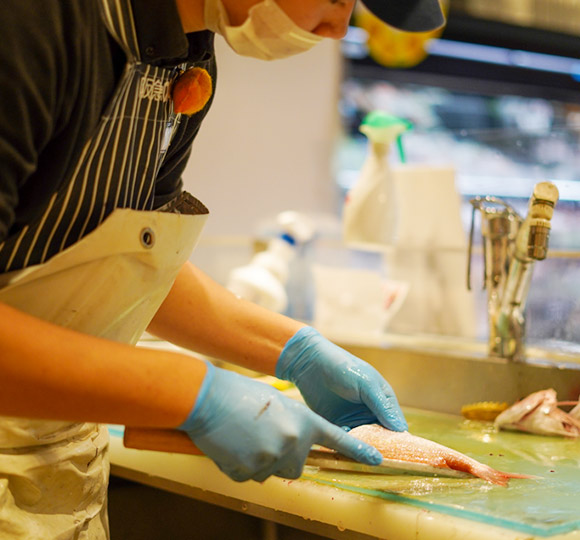
包丁を、魚に対して直角より5度くらい鋭角に当てるイメージで、尾から頭に向かって動かせば、ウロコを取ることができます。エラもエラぶたを開いて取り除きます。エラと口腔内は、海の中の浮遊物を含めてすべてのモノが通過する部分なので、最も汚い部分と言えます。 The image is that the kitchen knife is applied at an acute angle of about 5 degrees to the fish, and you can remove the scales by moving it from the tail to the head. The gills also opens the gills lid and removes it. The gills and the oral cavity are the parts through which all things, including floating substances in the sea, pass. We see it as the dirtiest part.
次に内臓を取ります。内臓は人間と同じで、口から肛門までしかありません。魚ののどの下から尾びれの方へ包丁を入れて魚の腹側を切れば、内臓が見えます。きれいに取り出しましょう。 Insert a knife from under the throat of the fish toward the tail fin and cut the ventral side of the fish to see the internal organs. Let's take it out cleanly.
内臓が出たら、腹腔から見える背骨に血液の塊があります。人間でいう腎臓で、下処理の最終はこれを取ります。丈夫な背骨なので、清潔な使用済みの箸などを使って掻き出しましょう。その後、水洗いし、腹腔内もきれいに洗い流します。 When the internal organs come out, there is a blood clot in the spine that can be seen from the abdominal cavity. In the human kidney, this is taken at the end of the pretreatment. It has a strong spine, so use a clean, used chopsticks to scrape it off. After that, wash it with water and rinse the abdominal cavity cleanly.
身を崩さないように注意して、水で血を洗い流すと良いでしょう。新鮮なものなら流水でも大丈夫です。基本的な下ごしらえはこれで完了です。 It's a good idea to wash your blood with water, being careful not to let the fish crumble. If it is fresh, running water is fine.This completes the basic preparation.
魚の切り方How to cut fish
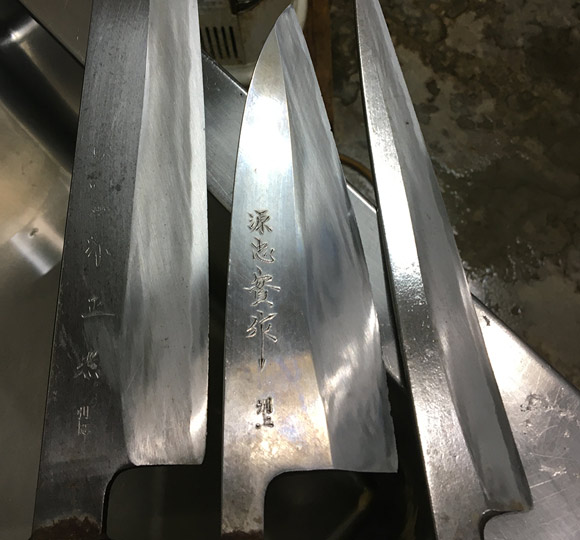
魚の代表的な切り方には、片身に背骨がついた「二枚おろし」、背骨を外して両側の身を使う「三枚おろし」、背骨に直角に切り分ける「ぶつ切り」などがあります。ぶつ切りは塩焼きや煮つけに向いていますが、火が通りにくいことがあるので、薄く「そぎ切り」にすることもできます。 Typical methods for cutting fish include "cutting two pieces" with a spine on one body, "cutting three pieces" with the spine removed, and "cutting into pieces" that cuts at right angles to the spine. Chopped pieces are suitable for grilling with salt or boiling, but they can be difficult to cook, so you can cut them into thin slices.
二枚おろしなら、エラぶたに沿って頭を落とします。三枚おろしの場合は胸びれを持ち上げてひれの下から頭を落とします。 If you cut two pieces, drop your head along the gills. In the case of fillet, lift the pectoral fin and drop the head from under the fin.
二枚おろしなら、頭側を利き手のほうに持っていき、腹側の腹腔の最後から背骨に沿って尾に向かって、包丁の先が背骨の中心に当たるように切っていきます。切り終わったら頭側を反対に向けて、背の尾のほうから頭に向けて、同じく背骨の中心に当たるように最後まで切ります。魚が大きい場合背骨中心まで届かないので、少しのぞき込んで背骨の中心まで切りましょう。 For filleting, bring the head side toward the dominant hand and cut from the end of the ventral abdominal cavity toward the tail along the spine so that the tip of the knife touches the center of the spine. After cutting, turn the head side in the opposite direction, from the tail of the back to the head, and cut to the end so that it also hits the center of the spine. If the fish is large, it will not reach the center of the spine, so look a little and cut it to the center of the spine.
切り終わったら尾側の最後の身を持ち上げ、背骨の真上を頭側まで切ってしまいます。大きい魚だと腹骨が固いので、いったん腹骨の手前で止めて尾側を持ち直し、少し強めに頭まで切り落とします。 After cutting, lift the last body on the caudal side and cut just above the spine to the head side. Large fish have a stiff abdomen, so stop in front of the abdomen, pick up the caudal side, and cut off to the head a little stronger.
三枚おろしは、大きい魚の場合は背骨の見えている側を上にして頭側を利き手のほうにし、二枚おろしと同じように腹腔から背骨に沿うように、包丁の先を背骨の中心まで切ります。切り終わったら頭側を反対に向けて、背の尾のほうから頭に向けて、同じく背骨の中心に当たるように最後まで切ります。魚が大きい場合背骨中心まで届かないので、少しのぞき込んで背骨の中心まで切っていきます。切り終わったら尾側の最後の身を持ち上げ、背骨の真上を頭側まで切ってしまいましょう。 In the case of large fish, fillet the spine with the visible side facing up and the head side toward the dominant hand. Cut. After cutting, turn the head side in the opposite direction, from the tail of the back to the head, and cut to the end so that it also hits the center of the spine. If the fish is large, it will not reach the center of the spine, so look a little and cut it to the center of the spine. When you're done cutting, lift the last body on the caudal side and cut just above the spine to the cranial side.
小さい魚の場合は、背骨側を下にして頭側を利き手のほうに持ってきて、背の頭のほうから背骨の中心に当たるように切り、頭側を反対に向けて尾側から腹腔に向けて背骨の中心まで切り、尾側の最後の身を持ち上げ、背骨の真上を頭側まで切ってしまいましょう。 For small fish, bring the spine side down and the head side toward the dominant hand, cut from the head of the back to the center of the spine, and turn the head side in the opposite direction from the caudal side to the abdominal cavity. Cut to the center of the spine, lift the last body on the caudal side, and cut just above the spine to the cranial side.
水洗いは最低限の時間で行いましょう。ウロコをとって内臓を出しただけの、「水洗い」の状態なら、表面に残ったウロコはしっかりと流水で洗い流すこと。お腹にはお箸などの硬いものを入れて、背骨付近に残っている血をしっかりと流水で洗い流します。 Wash with water in the minimum amount of time. If the scales are just taken and the internal organs are taken out, and the scales are "washed with water", the scales remaining on the surface should be thoroughly washed away with running water. Put a hard object such as chopsticks in your abdomen and wash away the blood remaining near your spine with running water.
刺身にするために三枚おろしにした場合でも、流水で3秒程度洗い、しっかりと水分をふき取ったほうが鮮度が保てます。 Even if you grate 3 pieces to make sashimi, you can keep the freshness by washing with running water for about 3 seconds and wiping off the water thoroughly.
最終に、キッチンペーパーでしっかり水気をとりましょう。薄く塩を振り、日本酒か、清酒と書かれた料理酒を少量振りかけて少しだけもみ込みます。フィレ状なら1枚ずつ、キッチンペーパーに厚めに包んみ、臭いが出ないように密閉袋に入れて、チルド室に保存します。 Finally, let's dry it well with kitchen paper. Sprinkle a little salt and a small amount of sake on it. In case of a fillet, wrap it in kitchen paper one by one, put it in a sealed bag so that it does not smell, and store it in a chilled room.
背骨をとらずに水洗いだけの場合は、キッチンペーパーで魚を包だけでなく、腹腔にもキッチンペーパーを詰めておきます。2、3時間ならそのままで問題ないですが、それ以上保管するときは、途中で何度かペーパーを変えるとさらに良いでしょう。不要な水分がキッチンペーパーににじみ出て、逆に臭いがついてしまうのが防げます。 In case of without removing the spine, not only wrap the fish, but also stuff the abdominal cavity with kitchen paper.If you want to store it longer, it's better to change the paper several times along the way.
どんな料理を食べたいですか?What kind of food do you want to eat?
それはあなた、またはパートナーの食べたい料理です! 青魚、白身魚にかかわらず、料理方法はさまざまですが、魚自体が出汁になるアミノ酸を持っていますので、それを生かした料理がおすすめです。基本的に使用するのは、「酒」「塩」「水」です。 It's the dish you or your partner wants to eat! Since the fish itself has amino acids that make soup stock, we recommend cooking that makes the best use of it. Basically, we use "liquor", "salt" and "water".
調味料として、和風なら醤油や味醂、洋風ならオリーブオイルやレモン、中華風なら豆板醤やラー油と、「煮」「焼」「蒸し」「揚げ」など、魚はどのような料理にも使えるスーパー食材です。 As seasonings, soy sauce and mirin for Japanese style, olive oil and lemon for Western style, and doubanjiang and chili oil for Chinese style, Fish such as "boiled", "baked", "steamed", and "fried" can be used in any dish.
必ずこうしなければ、という方程式はありません。ご自身でいろいろと試行錯誤して経験を積み重ねるのも、魚料理の醍醐味です。 It is the real pleasure of fish cooking to accumulate experience by trial and error on your own.
刺身にするには鮮度が大切ですが、それは魚屋さんに聞きましょう。刺身にできる鮮度かどうか聞くだけです。親切に教えてくれますよ。もちろん、魚屋さんの意見を参考に、鮮度をご自身で見極める気持ちを忘れずに。 Freshness is important for making sashimi, but ask the fishmonger about it. Just ask if it's fresh enough to make sashimi. They will kindly tell you. Of course, don't forget to refer to the fishmonger's opinion and determine the freshness yourself.





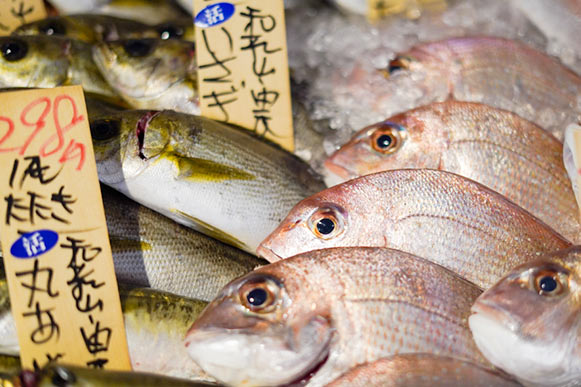 鮮魚の達人とは?
鮮魚の達人とは?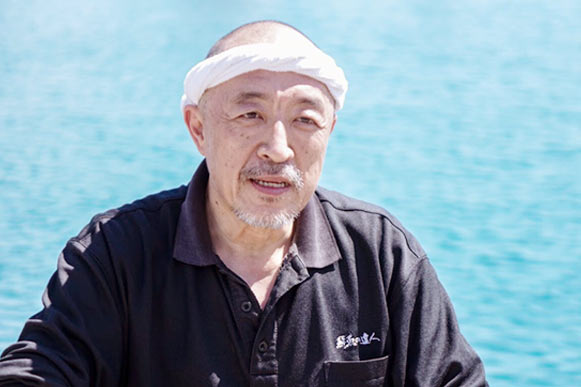 企業情報
企業情報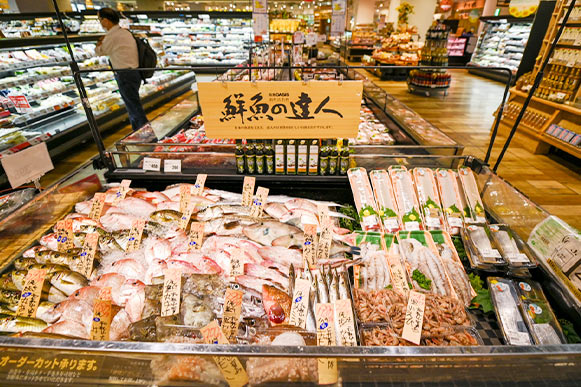 購入するには?
購入するには?